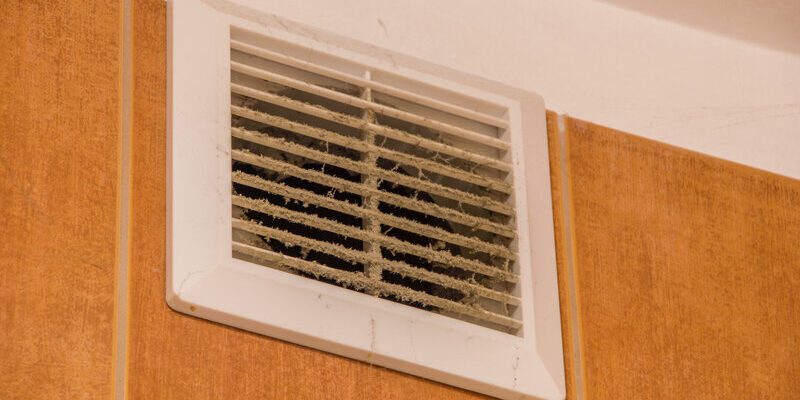- July 6, 2023
- in HVAC
- by Kyle Stewart
At first sniff, your HVAC system seems to be running perfectly well. But sooner or later, it may become apparent that something is a bit off. Are there strange smells coming from the air ducts? Is the air moving at a lower rate than it used to? Whatever the issues are, it’s possible that the solution lies in cleaning your air ducts.
Did you know that regular cleaning of the air ducts in your home can drastically reduce the amount of dust and other pollutants that get inside? It’s true! There’s no better way to ensure your home’s air quality remains top-notch than taking the time to clean your air ducts thoroughly.
But how do you know when your air ducts need cleaning? For many, this can be an overwhelming task, but don’t worry – we’ve got you! In this blog post, we’ll provide you with a step-by-step guide to help you identify when your air ducts need cleaning and how to go about doing it. Ready to learn more? Let’s get started!
Do My Air Ducts Need Cleaning?
If you notice dirt, dust, or debris coming out of your air ducts, it may be time to clean them. Additionally, if the air in your home begins smelling stale or musty, this is another sign that it is time to clean your air ducts.
Common Symptoms Of An Unhealthy Buildup
Sometimes, air ducts can become blocked with hair, dust, and other particles. This unhealthy buildup can lead to several concerning symptoms that may call for immediate attention. Allergy-prone individuals are more likely to suffer from symptoms of a contaminated system since their reactions to the foreign particles are so significant. Some common symptoms that an individual might experience when their air ducts need cleaning include:
- Itchy eyes, throat, and skin
- Coughing, sneezing, and shortness of breath
- Wheezing and chest tightness
- Fatigue
- Headaches
- Chills
- Nasal congestion
It is important to watch out for any of these signs as they could indicate an unhealthy buildup in your air ducts. Even if you do not experience any noticeable issues yourself, it is always worth getting your air ducts professionally cleaned every year for extra peace of mind.
Now that we have identified some of the common symptoms of an unhealthy buildup in the air ducts, let’s take a look at what else you should be looking out for.
What Should You Look Out For?
After acknowledging the common symptoms of an unhealthy buildup in your air ducts, it is important to get familiar with what you should be looking out for in order to determine if your air ducts need cleaning. Indoor air quality can greatly depend on the state and cleanliness of your ducts, so being observant of the following signs can go a long way in preventing any further health issues:
- An unusual amount of dust gathering on furniture
- A musty, wet odor around the ducts
- Visible dirt, mold, or mildew on the air ducts
- Unusually high energy bills due to additional strain from clogged ducts
- Excess noise from air movement inside the unit
While any of these signs may appear more subtle than others, collectively, they indicate that either the filter needs changing or an entire cleaning is required. It may be possible to ignore some of these indicators, but if little effort is made to address them, it could lead to long-term impacts, including respiratory and cardiovascular diseases as well as frequent colds and allergies.
In order to ensure clean air is circulated throughout your home or workplace, it is essential to carry out regular inspections and cleaning of your air ducts. This will help reduce extra costs, maintain the value of your property, and improve, most importantly, the overall health and safety of everyone living within its walls. We will cover how to do this inspection in our next section.
How To Inspect Your Air Ducts For Cleaning
Now that you know what to look out for when inspecting your air ducts, it is time to move on to the process of actually conducting the inspection. To start, turn off the ductilation and unearth it if possible. Make sure to wear protective gear, such as gloves and a mask if needed, to protect yourself from any dust or debris. Once the duct is exposed, carefully look into it with a flashlight and take note of any blockages or buildup. Look out for signs of mold growth, which can be dangerous, as well as measuring the length of air passages being blocked.
It is also wise to clean and inspect your air ducts regularly rather than waiting until a problem arises. Regular maintenance can identify problems early on and prevent them from getting worse while also allowing easier access for cleaning when necessary. Also, pay close attention to rural areas, and places that are rarely occupied since ductilation systems in these locations will likely go unnoticed for months at a time.
Once you have noted down all the issues you noticed during the inspection, it is time to move on to actually clearing any blockages from your air ducts. This will require further preparation and safety checks in order to avoid any potential harm or danger due to the mess and debris that could go flying around during the process. Therefore, proceed with caution when handling your air ducts!
Clearing Blockages When Your Air Ducts Need Cleaning
Clearing blockages from air ducts is an important step in ensuring efficient airflow throughout your home. While many homeowners may be tempted to get out a vacuum and suck out all the debris, this can actually cause more harm than good by loosening particles that can then enter your home or HVAC system, potentially causing further damage. The most effective method for clearing away hazardous buildups is to dust, brush, or wash away obstructions with air duct-safe cleaning materials.
Many professionals recommend using pressurized air devices or stiff brushes and vacuums instead of chemical cleaners when dealing with particularly stubborn blockages. For example, a brush attachment on a vacuum cleaner may be used to effectively remove dust and debris from around the edges of the duct without releasing any unwanted pollutants inside. Regardless of the tools chosen to clear away blockages, it’s imperative that all other ductilation systems are kept shut off while work is being done so as not to cause any disruption to their normal function. Additionally, dust masks should be worn to protect against airborne irritants and latex gloves should be worn when handling damp parts of the ducting system.
After inspecting and clearing blockages from your air ducts, it’s time to turn our attention to prevention. Regularly cleaning your air ducts can reduce unhealthy buildups so that you can ensure optimal airflow for years to come.
Prevent Unhealthy Buildup From Happening
Preventing unhealthy buildup from happening in your air ducts is the best way to ensure that you don’t have to clear blockages in the first place. One of the most effective ways to prevent clogs and blockages is to clean your air duct and the area surrounding the duct on a regular basis. Vacuuming or dusting on a frequent basis will help remove any dirt, dust, and debris that can accumulate around your air duct and cause a clog.
Regularly replacing your duct filters is also a great preventative measure that should not be overlooked. These filters are designed to capture airborne particles before they enter your home. However, if these filters are too clogged up with dirt, dust, pollen, and other particles, they won’t be able to do their job efficiently. Check your filter monthly to make sure it isn’t too dirty, and replace it when needed.
In addition, choosing high-quality air ducts with tight-fitting seals can help make sure you maintain an adequate air supply in your home while also keeping out unwanted debris. Poorly fitted or aging air ducts may cause air leakage, which can reduce the efficiency of filtered ductilation systems as well as reduce indoor air quality by allowing contaminated outside airflow into your home. Furthermore, make sure there’s proper insulation around windows and doors as well as around exposed sections of your ductwork to minimize the risk of mold buildup due to condensation.
Overall, preventing unhealthy buildup from happening in your air ducts is essential for avoiding costly repairs and ensuring good indoor air quality for you and your family. Regular cleaning, filter replacement, properly fitted ductwork, and insulation can all help keep contaminants out of your home’s ductilation system while maintaining efficient airflow so you can enjoy healthy and comfortable living spaces. To further ensure the cleanliness and effectiveness of your air ducts, consider implementing DIY duct sanitization steps. This may include using natural cleaners such as vinegar or baking soda to freshen up the ducts, as well as sealing any leaks or gaps in the ductwork to prevent the entry of pollutants. By taking these proactive measures, you can help extend the lifespan of your HVAC system and promote a healthier indoor environment for you and your loved ones.
Answers To Commonly Asked Air Duct Questions
What are the signs that my air ducts need cleaning?
The most obvious sign that your air ducts need to be cleaned is when they start to look visibly dirty. This could present itself as dust, dirt, or other debris stuck in the ducts. If you can see a buildup of these materials in your ducts, it’s time to clean.
In addition to visual signs, there are also environmental factors to consider. If you start noticing strange smells coming from the air ducts when they are running, this could be a sign of mold or mildew growth due to trapped moisture. This sign should not be ignored, and the ducts should immediately be cleaned before any further damage is done.
Finally, if your airflow seems noticeably weaker than usual or heated/ cooled air is having trouble reaching certain rooms in your house, this could also indicate that there is something blocking your air ducts, preventing smooth airflow throughout your home. In this case, debris should be removed, and the ducts may need to be professionally cleaned by an HVAC specialist.
How often should I clean my air ducts?
It is recommended to clean your air ducts every three months. This schedule allows you to detect and prevent any dust or debris buildup that can interfere with the efficiency of your HVAC system. Additionally, keeping your air ducts free of dirt and dust particles can help reduce airborne allergens that may be inside your home. Regular cleaning helps maintain optimal indoor air quality and extends the life of your air ducts.
What is the best way to clean air ducts?
The best way to clean air ducts depends on the type of duct you have in your home. For supply ducts, which are usually plastic or metal and carry conditioned air from your furnace or air conditioner into the rooms of your home, the best method of cleaning is vacuuming. Remove the covers from the duct, use a vacuum hose attachment to remove any dirt and debris, then replace the covers. For return vents, which suck air from the various rooms in your home back into the ductwork system, it is best to use a brush and some mild detergent. Dip the brush in warm water and detergent, then carefully scrub around all sides of the duct to get rid of any dirt or dust. Additionally, a damp cloth with a mild detergent solution can be used to wipe away any dust that may remain afterward.
When You’re Ready To Clean Your Homes Air Ducts
When your air ducts need cleaning and you don’t want to do it yourself then give us a call! We’re here to help keep your home’s air ducts clean. Contact us at (904) 851-0355.






